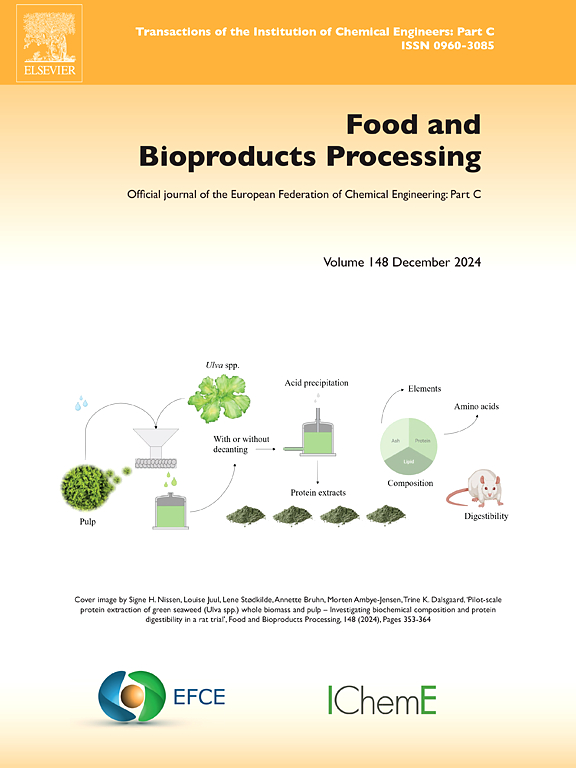Enhancing the solubility and pH stability of curcumin through polyvinylpyrrolidone conjugation for improving their bioavailability and use in fruit preservation
IF 3.4
2区 农林科学
Q2 BIOTECHNOLOGY & APPLIED MICROBIOLOGY
引用次数: 0
Abstract
Curcumin, a natural antioxidant and antimicrobial compound, shows great potential in food preservation due to its ability to inhibit microbial growth and oxidation. However, its limited water solubility and pH instability hinder its practical applications. To address these issues, curcumin was conjugated with polyvinylpyrrolidone (PVP) using a solid dispersion technique, resulting in a water-dispersible and stable formulation. The PVP-curcumin conjugate was characterized using Fourier Transform Infrared Spectroscopy (FTIR), X-ray diffraction (XRD), and Scanning Electron Microscopy (SEM), confirming the successful formation of an amorphous complex. Solubility studies showed that the conjugate entirely dissolved in water, whereas native curcumin mainly remained insoluble. Stability tests across a pH range of 1–12 demonstrated that PVP significantly enhanced the stability of curcumin, particularly under alkaline conditions. The antimicrobial activity of the PVP/Cur conjugate was assessed using the well diffusion method against Escherichia coli, Salmonella enterica, Pseudomonas aeruginosa, and Staphylococcus aureus. The inhibition zones ranged from 24 to 29 mm. Additionally, its application as a peach coating under non-ideal storage conditions (27–40°C) resulted in a significant reduction in moisture loss and microbial spoilage, thereby extending the shelf life to 12–24 days. This study highlights the multifunctional benefits of PVP/Cur, including enhanced solubility, bioavailability, and antimicrobial efficacy. These findings suggest its potential as a sustainable and innovative solution for food preservation and improving the post-harvest quality of perishable products.
通过聚乙烯吡咯烷酮偶联提高姜黄素的溶解度和pH稳定性,提高其生物利用度和在水果保鲜中的应用
姜黄素是一种天然的抗氧化剂和抗菌化合物,由于其抑制微生物生长和氧化的能力,在食品保存中显示出巨大的潜力。然而,其有限的水溶性和pH不稳定性阻碍了其实际应用。为了解决这些问题,采用固体分散技术将姜黄素与聚乙烯吡咯烷酮(PVP)偶联,得到了水分散的稳定配方。利用傅里叶变换红外光谱(FTIR)、x射线衍射(XRD)和扫描电镜(SEM)对pvp -姜黄素缀合物进行了表征,证实其成功形成了无定形配合物。溶解度研究表明,该缀合物完全溶于水,而天然姜黄素主要不溶于水。在1-12的pH范围内的稳定性测试表明PVP显著提高了姜黄素的稳定性,特别是在碱性条件下。采用孔扩散法测定PVP/Cur偶联物对大肠埃希菌、肠炎沙门氏菌、铜绿假单胞菌和金黄色葡萄球菌的抑菌活性。抑制区范围为24 ~ 29 mm。此外,在非理想储存条件下(27-40°C),将其用作桃子涂层,可显著减少水分损失和微生物腐败,从而将保质期延长至12-24天。这项研究强调了PVP/Cur的多功能益处,包括提高溶解度、生物利用度和抗菌功效。这些发现表明,它有潜力成为一种可持续的创新解决方案,用于食品保存和提高易腐产品的收获后质量。
本文章由计算机程序翻译,如有差异,请以英文原文为准。
求助全文
约1分钟内获得全文
求助全文
来源期刊

Food and Bioproducts Processing
工程技术-工程:化工
CiteScore
9.70
自引率
4.30%
发文量
115
审稿时长
24 days
期刊介绍:
Official Journal of the European Federation of Chemical Engineering:
Part C
FBP aims to be the principal international journal for publication of high quality, original papers in the branches of engineering and science dedicated to the safe processing of biological products. It is the only journal to exploit the synergy between biotechnology, bioprocessing and food engineering.
Papers showing how research results can be used in engineering design, and accounts of experimental or theoretical research work bringing new perspectives to established principles, highlighting unsolved problems or indicating directions for future research, are particularly welcome. Contributions that deal with new developments in equipment or processes and that can be given quantitative expression are encouraged. The journal is especially interested in papers that extend the boundaries of food and bioproducts processing.
The journal has a strong emphasis on the interface between engineering and food or bioproducts. Papers that are not likely to be published are those:
• Primarily concerned with food formulation
• That use experimental design techniques to obtain response surfaces but gain little insight from them
• That are empirical and ignore established mechanistic models, e.g., empirical drying curves
• That are primarily concerned about sensory evaluation and colour
• Concern the extraction, encapsulation and/or antioxidant activity of a specific biological material without providing insight that could be applied to a similar but different material,
• Containing only chemical analyses of biological materials.
 求助内容:
求助内容: 应助结果提醒方式:
应助结果提醒方式:


